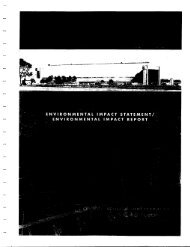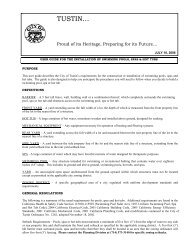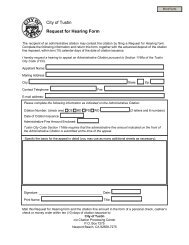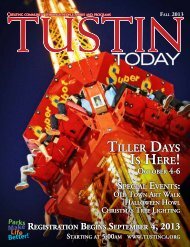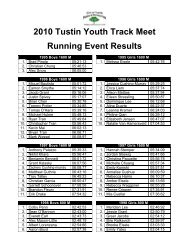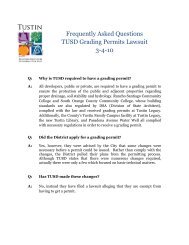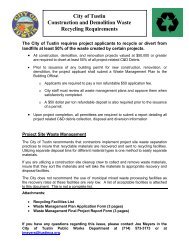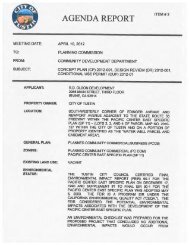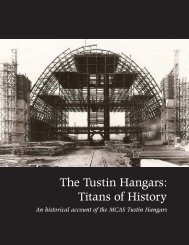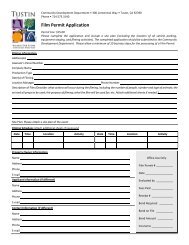the neighborhoods of tustin town center: a new ... - City of Tustin
the neighborhoods of tustin town center: a new ... - City of Tustin
the neighborhoods of tustin town center: a new ... - City of Tustin
You also want an ePaper? Increase the reach of your titles
YUMPU automatically turns print PDFs into web optimized ePapers that Google loves.
LAND USE AND TRIP GENERATION<br />
The land uses and trip generation for each neighborhood area and alternatives illustrated in<br />
Figures 4 through 9 are summarized in Tables 2 through 4. The highest Alternative A increase<br />
over existing, by approximately 35%, occurs in Center <strong>City</strong> whereas Sou<strong>the</strong>rn Gateway and<br />
West Village proposed land use changes increase around 20% and 5%, respectively. The trips<br />
generated by <strong>the</strong> land uses assumed in Alternative A for any neighborhood area indicate that<br />
it is less intense than Alternative B by as much as 15% on a daily basis as in <strong>the</strong> case in Center<br />
<strong>City</strong>. Alternative B can be intense by as much as 51% compared to existing and 29% and 15% in<br />
Sou<strong>the</strong>rn Gateway and West Village, respectively. There are three neighborhood areas (Center<br />
<strong>City</strong>, Sou<strong>the</strong>rn Gateway, and West Village) each with two circulation plans that are referred to in this<br />
report as Neighborhood Plans (Alternatives A and B) and two land use alternatives (Alternatives<br />
A and B). The traffic evaluation carried out here for worse-case evaluation purposes uses <strong>the</strong> land<br />
use alternative with <strong>the</strong> highest trip generation (Alternative B) for each Neighborhood Plan under<br />
existing conditions in each <strong>of</strong> <strong>the</strong> Neighborhood Areas. However, it is likely <strong>the</strong> final development<br />
plan for <strong>Tustin</strong> Town Center will be a combination <strong>of</strong> circulation (such as Neighborhood Plan) and<br />
land use alternatives for each Neighborhood Area presented in Figures 4 through 9 and Tables<br />
2 through 4.<br />
EXISTING CONDITIONS<br />
Figure 10 presents <strong>the</strong> circulation system within <strong>the</strong> study area. The existing ADT volumes<br />
are illustrated in Figure 11 and <strong>the</strong> select key intersections evaluated are shown in Figure 12.<br />
Drivers are more likely to perceive traffic problem at intersections ra<strong>the</strong>r than roadway segments,<br />
<strong>the</strong>refore <strong>the</strong> performance <strong>of</strong> intersections using peak hour data is <strong>the</strong> main emphasis <strong>of</strong> <strong>the</strong><br />
evaluation given here. The ICU values for <strong>the</strong>se intersections are summarized in Table 5. As can<br />
be seen here, all intersections are operating better than <strong>the</strong> acceptable level <strong>of</strong> service “D” (ICU<br />
= .90) with LOS “C” or better (ICU = .80 or below). The worst performing intersection with a PM<br />
peak hour ICU <strong>of</strong> .71 under existing conditions is Pasadena Avenue at McFadden Avenue.<br />
Future conditions that are not analyzed here but could affect travel patterns include <strong>the</strong> extension<br />
<strong>of</strong> Newport Avenue from just south <strong>of</strong> Sycamore Avenue to Edinger Avenue which will particularly<br />
affect traffic on Newport Avenue in <strong>the</strong> Sou<strong>the</strong>rn Gateway. To what extent will be <strong>the</strong> subject <strong>of</strong><br />
fur<strong>the</strong>r study at a later date.<br />
A-10 THE NEIGHBORHOODS OF TUSTIN TOWN CENTER<br />
MARKET ANALYSIS AND NEIGHBORHOOD CONCEPT PLANS<br />
STRATEGIC GUIDE 09.21.2010



